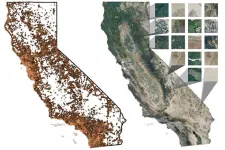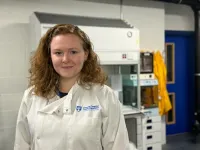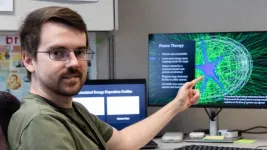(Press-News.org) With the help of deep learning, University of California, Berkeley, scientists have leveraged citizen science data from the app iNaturalist to create the highest resolution maps yet of plant distributions throughout California.
iNaturalist is a widely-used cellphone app, originally developed by UC Berkeley students, that allows people to upload photos and the location data of plants, animals or any other life they encounter and then crowdsource their identity. The app currently has more than 8 million users worldwide who collectively have uploaded more than 200 million observations.
The researchers used a type of artificial intelligence called a convolutional neural network, which is a deep learning model, to correlate the citizen science data for plants in California with high-resolution remote-sensing satellite or airplane images of the state. The network discovered correlations that were then used to predict the current range of 2,221 plant species throughout California, down to scales of a few square meters.
Botanists usually build high-quality maps of species by painstakingly listing all plant species in an area, but this is not feasible outside of a few small natural areas or national parks. Instead, the AI model, called Deepbiosphere, leverages free data from iNaturalist and remote sensing airplanes or satellites that now cover the entire globe. Given enough observations by citizen scientists, the model could be deployed in countries lacking detailed scientific data on plant distributions and habitats to monitor vegetation change, such as deforestation or regrowth after wildfires.
The findings were published Sept. 5 in the journal Proceedings of the National Academy of Sciences by Moisés "Moi" Expósito-Alonso, a UC Berkeley assistant professor of integrative biology, first author Lauren Gillespie, a doctoral student in computer science at Stanford University, and their colleagues. Gillespie currently has a Fulbright U.S. Student Program grant to use similar techniques to detect patterns of plant biodiversity in Brazil.
“During my year here in Brazil, we’ve seen the worst drought on record and one of the worst fire seasons on record,” Gillespie said. “Remote sensing data so far has been able to tell us where these fires have happened or where the drought is worst, and with the help of deep learning approaches like Deepbiosphere, soon it will tell us what’s happening to individual species on the ground.”
"That is a goal — to expand it to many places," Expósito-Alonso said. "Almost everybody in the world has smartphones now, so maybe people will start taking pictures of natural habitats and this will be able to be done globally. At some point, this is going to allow us to have layers in Google Maps showing where all the species are, so we can protect them. That's our dream."
Apart from being free and covering most of Earth, remote sensing data are also more fine-grained and more frequently updated than other information sources, such as regional climate maps, which often have a resolution of a few kilometers. Using citizen science data with remote sensing images — just the basic infrared maps that provide only a picture and the temperature — could allow daily monitoring of landscape changes that are hard to track.
Such monitoring can help conservationists discover hotspots of change or pinpoint species-rich areas in need of protection.
"With remote sensing, almost every few days there are new pictures of Earth with 1 meter resolution," Expósito-Alonso said. "These now allow us to potentially track in real time shifts in distributions of plants, shifts in distributions of ecosystems. If people are deforesting remote places in the Amazon, now they cannot get away with it — it gets flagged through this prediction network."
Expósito-Alonso, who moved from Stanford to UC Berkeley earlier this year, is an evolutionary biologist interested in how plants evolve genetically to adapt to climate change.
"I felt an urge to have a scalable method to know where plants are and how they're shifting," he said. "We already know that they're trying to migrate to cooler areas, that they're trying to adapt to the environment that they're facing now. The core part of our lab is understanding those shifts and those impacts and whether plants will evolve to adapt."
In the study, the researchers tested Deepbiosphere by excluding some iNaturalist data from the AI training set and then later asking the AI model to predict the plants in the excluded area. The AI model had an accuracy of 89% in identifying the presence of species, compared to 27% for previous methods. They also pitted it against other models developed to predict where plants are growing around California and how they will migrate with rising temperatures and changing rainfall. One of these models is Maxent, developed at the American Museum of Natural History, that uses climate grids and georeferenced plant data. Deepbiosphere performed significantly better than Maxent.
They also tested Deepbiosphere against detailed plant maps created for some of the state's parks. It predicted with 81.4% accuracy the location of redwoods in Redwood National Park in Northern California and accurately captured (with R2=0.53) the burn severity caused by the 2013 Rim Fire in Yosemite National Park.
"What was incredible about this model that Lauren came up with is that you are just training it with publicly available data that people keep uploading with their phones, but you can extract enough information to be able to create nicely defined maps at high resolution," Expósito-Alonso said. "The next question, once we understand the geographic impacts, is, “Are plants going to adapt?’"
Megan Ruffley, also of the Carnegie Institution for Science at Stanford, is a co-author of the paper. The research, which began when Expósito-Alonso was a staff associate at the Carnegie Institution for Science and an assistant professor at Stanford, was funded by the Carnegie Institution for Science.
END
Using AI and iNaturalist, scientists build one of the highest resolution maps yet of California plants
Citizen scientists can help monitor the state's plants in the face of global change
2024-10-11
ELSE PRESS RELEASES FROM THIS DATE:
Researchers identify signs tied to more severe cases of RSV
2024-10-11
Respiratory syncytial virus (RSV) is the leading cause of hospitalization in young children due to respiratory complications such as bronchiolitis and pneumonia. Yet little is understood about why some children develop only mild symptoms while others develop severe disease. To better understand what happens in these cases, clinician-scientists from Brigham and Women’s Hospital, a founding member of the Mass General Brigham healthcare system, and Boston Children’s Hospital analyzed samples from patients’ airways and ...
Mays Cancer Center radiation oncologist recognized as outstanding mentor to next generation leaders
2024-10-11
SAN ANTONIO, Oct. 11, 2024 – David Gius, MD, PhD, professor in the Department of Radiation Oncology and assistant dean of research at The University of Texas Health Science Center at San Antonio (UT Health San Antonio), was named this year’s recipient of the prestigious American Society for Radiation Oncology (ASTRO) Career Recognition Mentorship Award.
Gius is associate cancer center director for translational research at Mays Cancer Center at UT Health San Antonio. He is among three awardees receiving this recognition. The award honors individuals who have made significant contributions to mentorship ...
Hitting the bull’s eye to target ‘undruggable’ diseases – researchers reveal new levels of detail in targeted protein degradation
2024-10-11
Hitting the bull’s eye to target ‘undruggable’ diseases – researchers reveal new levels of detail in targeted protein degradation
Targeted protein degradation has opened up a new field of drug discovery with potential to treat previously ‘undruggable’ diseases
Dundee researchers have revealed new levels of details of how protein degraders work
The work means new drugs can be much more accurately targeted at the molecular level, creating and hitting a metaphorical ...
SCAI publishes expert consensus statement on managing patients with ST-elevated myocardial infarction
2024-10-11
WASHINGTON —The Society for Cardiovascular Angiography & Interventions (SCAI) is pleased to announce the publication of the Expert Consensus Statement on the Management of Patients with STEMI Referred for Primary PCI.
Published in JSCAI, the consensus statement provides detailed suggestions for clinicians, particularly for nuanced situations not covered by general guidelines. It highlights the strengths and limitations of various diagnostic and therapeutic interventions for treating patients with STEMI, provides ...
Engineering perovskite materials at the atomic level paves way for new lasers, LEDs
2024-10-11
Researchers have developed and demonstrated a technique that allows them to engineer a class of materials called layered hybrid perovskites (LHPs) down to the atomic level, which dictates precisely how the materials convert electrical charge into light. The technique opens the door to engineering materials tailored for use in next-generation printed LEDs and lasers – and holds promise for engineering other materials for use in photovoltaic devices.
Perovskites, which are defined by their crystalline ...
Kessler Foundation 2024 Survey highlights key strategies for hiring and supporting workers with disabilities in the hospitality industry
2024-10-11
East Hanover, NJ – October 11, 2024 – A new Kessler Foundation survey of supervisors in the hospitality industry – focused on restaurant and traveler accommodations – has revealed critical insights into the recruitment, support, and accommodation of workers with disabilities. The findings, released today in a special live Zoom webinar, offer actionable takeaways for employers looking to diversify their workforce and enhance workplace inclusion. Key points revealed that proactive recruitment, effective partnerships, and ...
Harnessing protons to treat cancer
2024-10-11
NEWPORT NEWS, VA – Radiation therapy techniques have been used for more than a century to treat cancers. Physicists in the Radiation Detector and Imaging group and associated with the Biomedical Research & Innovation Center (BRIC) at the U.S. Department of Energy’s Thomas Jefferson National Accelerator Facility have been for several years pursuing radiation therapy technology improvements in collaboration with the Hampton University Proton Cancer Institute (HUPCI). Now, BRIC physicists are launching a study into how best to advance different types of radiation therapy.
BRIC scientists plan to evaluate the ability of accelerator-based ...
Researchers identify neurodevelopmental symptoms that indicate genetic disorders
2024-10-11
In a new study, UCLA Health researchers have found that motor delay and low muscle tone were common signs of an underlying genetic diagnosis in children with neurodevelopment disorders.
Given the limited existing data on the early neurodevelopmental symptoms that predict a positive genetic diagnosis, the study authors aimed to research which factors in this subset of children indicated the need of a genetic test. “With genetic testing, a diagnostic result can have benefits on medical care, but ...
Electronic nudges to increase influenza vaccination in patients with chronic diseases
2024-10-11
About The Study: In a nationwide randomized clinical implementation trial, electronically delivered letter-based nudges markedly increased influenza vaccination compared with usual care among young and middle-aged patients with chronic diseases. The results of this study suggest that simple, scalable, and cost-efficient electronic letter strategies may have substantial public health implications.
Corresponding Author: To contact the corresponding author, Tor Biering-Sorensen, MD, MSc, MPH, PhD, email tor.biering@gmail.com.
To access the embargoed ...
Plant stem cells: Better understanding the biological mechanism of growth control
2024-10-11
Plants form new leaves, flowers and roots at the tips of shoots and roots, in specific growth regions known as meristems. These meristems contain stem cells that divide as needed and form new cells that develop into specialised tissue. Using the example of plant roots, researchers from Freiburg have now been able to decipher which regulatory mechanisms ensure that growth in the meristem occurs in a controlled manner. The results have been published in the journal Nature Plants.
Stem cells are dependent on ...
LAST 30 PRESS RELEASES:
Longest observation of an active solar region
Why nail-biting, procrastination and other self-sabotaging behaviors are rooted in survival instincts
Regional variations in mechanical properties of porcine leptomeninges
Artificial empathy in therapy and healthcare: advancements in interpersonal interaction technologies
Why some brains switch gears more efficiently than others
UVA’s Jundong Li wins ICDM’S 2025 Tao Li Award for data mining, machine learning
UVA’s low-power, high-performance computer power player Mircea Stan earns National Academy of Inventors fellowship
Not playing by the rules: USU researcher explores filamentous algae dynamics in rivers
Do our body clocks influence our risk of dementia?
Anthropologists offer new evidence of bipedalism in long-debated fossil discovery
Safer receipt paper from wood
Dosage-sensitive genes suggest no whole-genome duplications in ancestral angiosperm
First ancient human herpesvirus genomes document their deep history with humans
Why Some Bacteria Survive Antibiotics and How to Stop Them - New study reveals that bacteria can survive antibiotic treatment through two fundamentally different “shutdown modes”
UCLA study links scar healing to dangerous placenta condition
CHANGE-seq-BE finds off-target changes in the genome from base editors
The Journal of Nuclear Medicine Ahead-of-Print Tip Sheet: January 2, 2026
Delayed or absent first dose of measles, mumps, and rubella vaccination
Trends in US preterm birth rates by household income and race and ethnicity
Study identifies potential biomarker linked to progression and brain inflammation in multiple sclerosis
Many mothers in Norway do not show up for postnatal check-ups
Researchers want to find out why quick clay is so unstable
Superradiant spins show teamwork at the quantum scale
Cleveland Clinic Research links tumor bacteria to immunotherapy resistance in head and neck cancer
First Editorial of 2026: Resisting AI slop
Joint ground- and space-based observations reveal Saturn-mass rogue planet
Inheritable genetic variant offers protection against blood cancer risk and progression
Pigs settled Pacific islands alongside early human voyagers
A Coral reef’s daily pulse reshapes microbes in surrounding waters
EAST Tokamak experiments exceed plasma density limit, offering new approach to fusion ignition
[Press-News.org] Using AI and iNaturalist, scientists build one of the highest resolution maps yet of California plantsCitizen scientists can help monitor the state's plants in the face of global change




